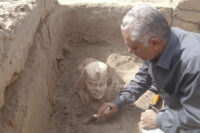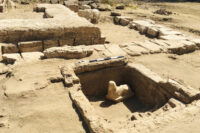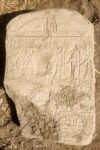 A limestone sphinx from the early Roman Imperial era has been unearthed near the Temple of Hathor in Dendera, 300 miles south of Cairo. The small sphinx was discovered inside a Roman-era shrine. A limestone stele with an inscription written in both hieroglyphics and demotic was found next to the sphinx.
A limestone sphinx from the early Roman Imperial era has been unearthed near the Temple of Hathor in Dendera, 300 miles south of Cairo. The small sphinx was discovered inside a Roman-era shrine. A limestone stele with an inscription written in both hieroglyphics and demotic was found next to the sphinx.
Located just east of the Temple of Dendera, the shrine was a two-level platform carved in limestone with stairs leading down to the foundation layer. At the bottom is a Byzantine-era water storage basin made of mudbrick. The sphinx and stela were inside the basin.
 The human face on the lion body of the sphinx wears a placid archaic smile with dimples on each side of his lips. He dons the nemes headdress — the striped cloth headdress worn by Egypt’s pharaohs — with the uraeus — the upright cobra that symbolized royal authority — on his forehead. Traces of yellow and red paint have survived on his face.
The human face on the lion body of the sphinx wears a placid archaic smile with dimples on each side of his lips. He dons the nemes headdress — the striped cloth headdress worn by Egypt’s pharaohs — with the uraeus — the upright cobra that symbolized royal authority — on his forehead. Traces of yellow and red paint have survived on his face.
The facial features are similar to those on statues of the Emperor Claudius (r. 41-54 A.D.), pharaonic name Tiberios Klaudios Kaisaros Sebastos Germanikos Autokrator, who was titled in a hieroglyphic inscription on the exterior wall of the Temple of Isis at Shanhur 30 miles south of Dendera as “Son of Ra, Lord of the Crowns, King of Upper and Lower Egypt, Lord of the Two Lands.” Archaeologists hope the stele’s inscription may identify the pharaoh being depicted on the sphinx.
 With the death of Cleopatra VII, the dynasties of Egyptian pharaohs came to an end. Augustus absorbed Egypt into the Roman Empire but the emperors retained the traditional accoutrements of pharaohs to lend cultural legitimacy to their rules. Roman emperors continued to be styled as Egyptian pharaohs into the 4th century. These iconographic associations were all the more important because most emperors, including Claudius, never visited Egypt in person.
With the death of Cleopatra VII, the dynasties of Egyptian pharaohs came to an end. Augustus absorbed Egypt into the Roman Empire but the emperors retained the traditional accoutrements of pharaohs to lend cultural legitimacy to their rules. Roman emperors continued to be styled as Egyptian pharaohs into the 4th century. These iconographic associations were all the more important because most emperors, including Claudius, never visited Egypt in person.